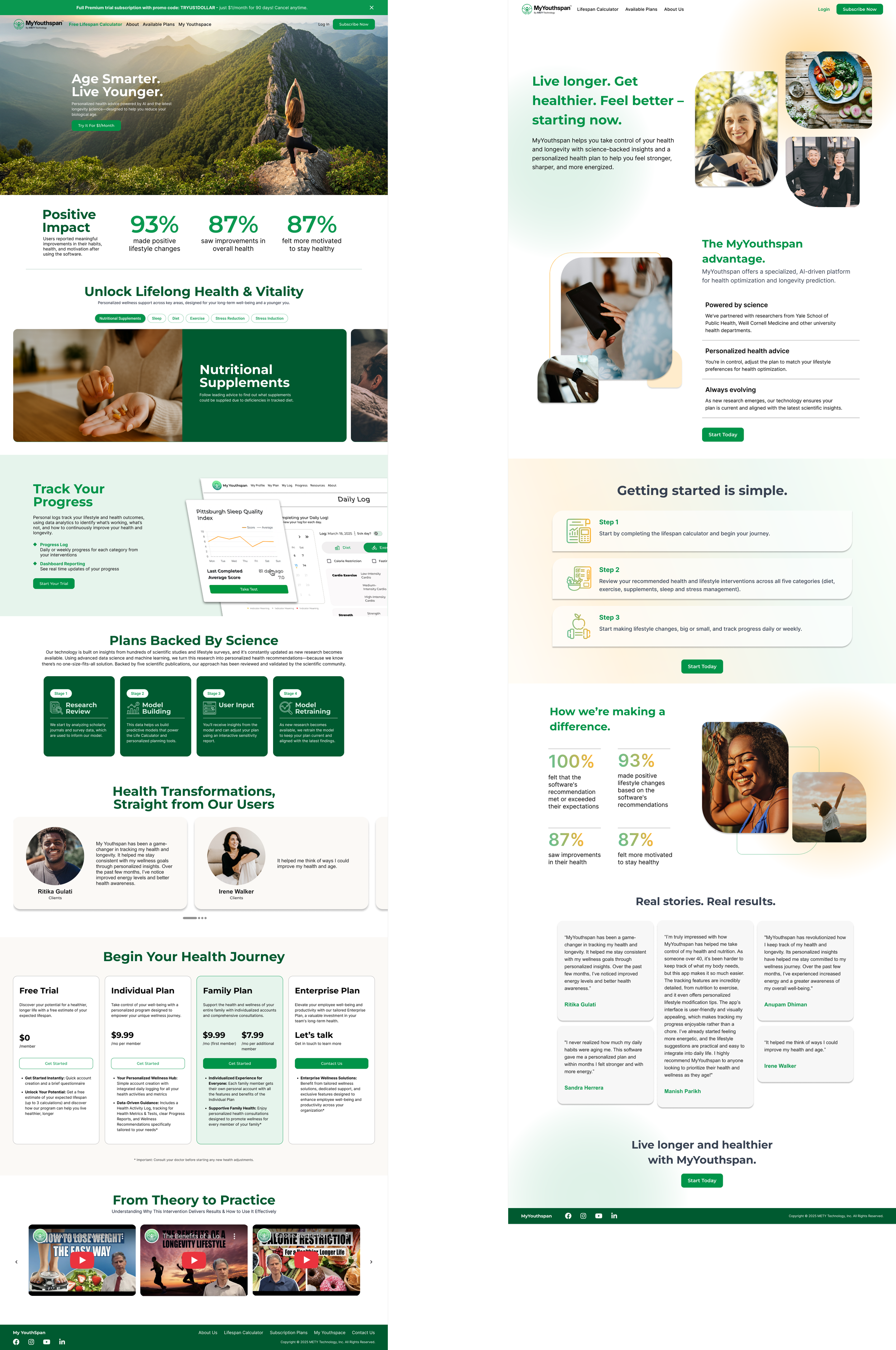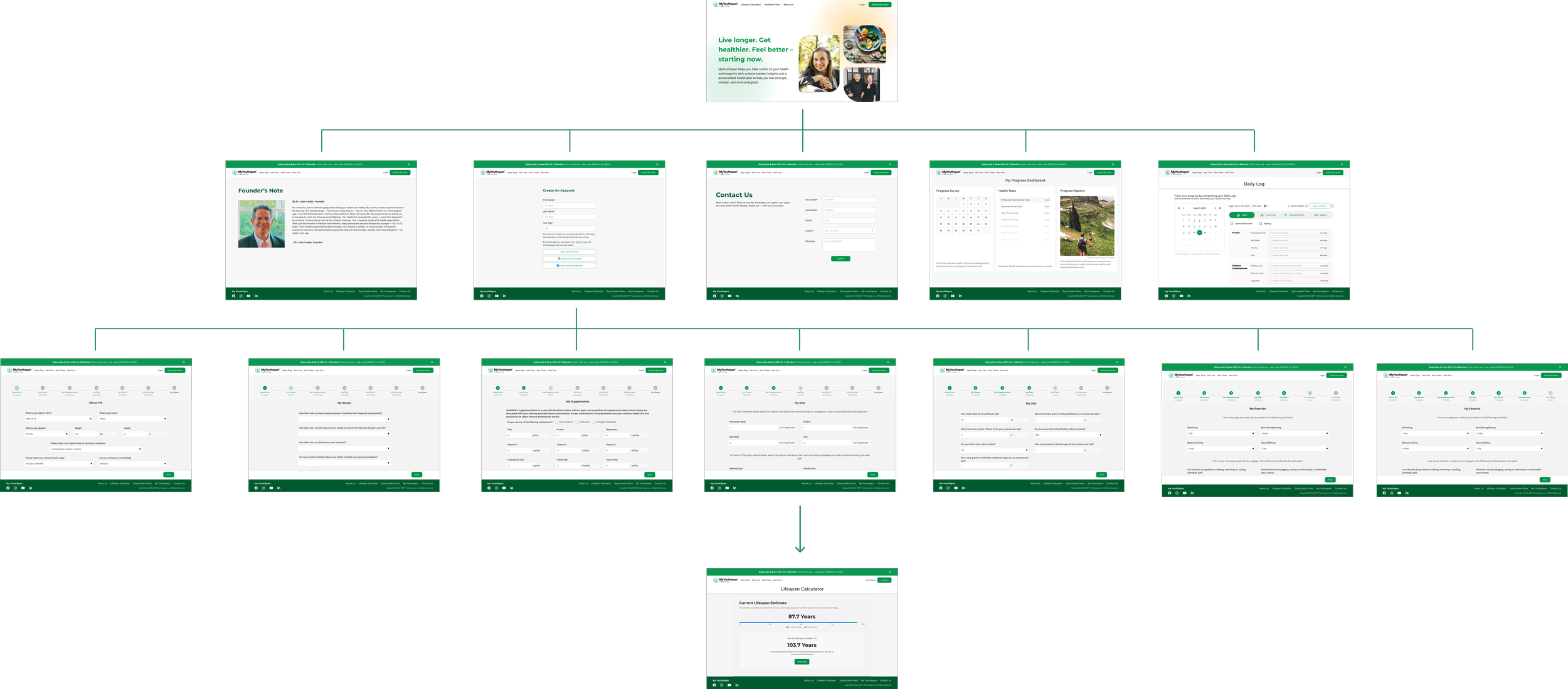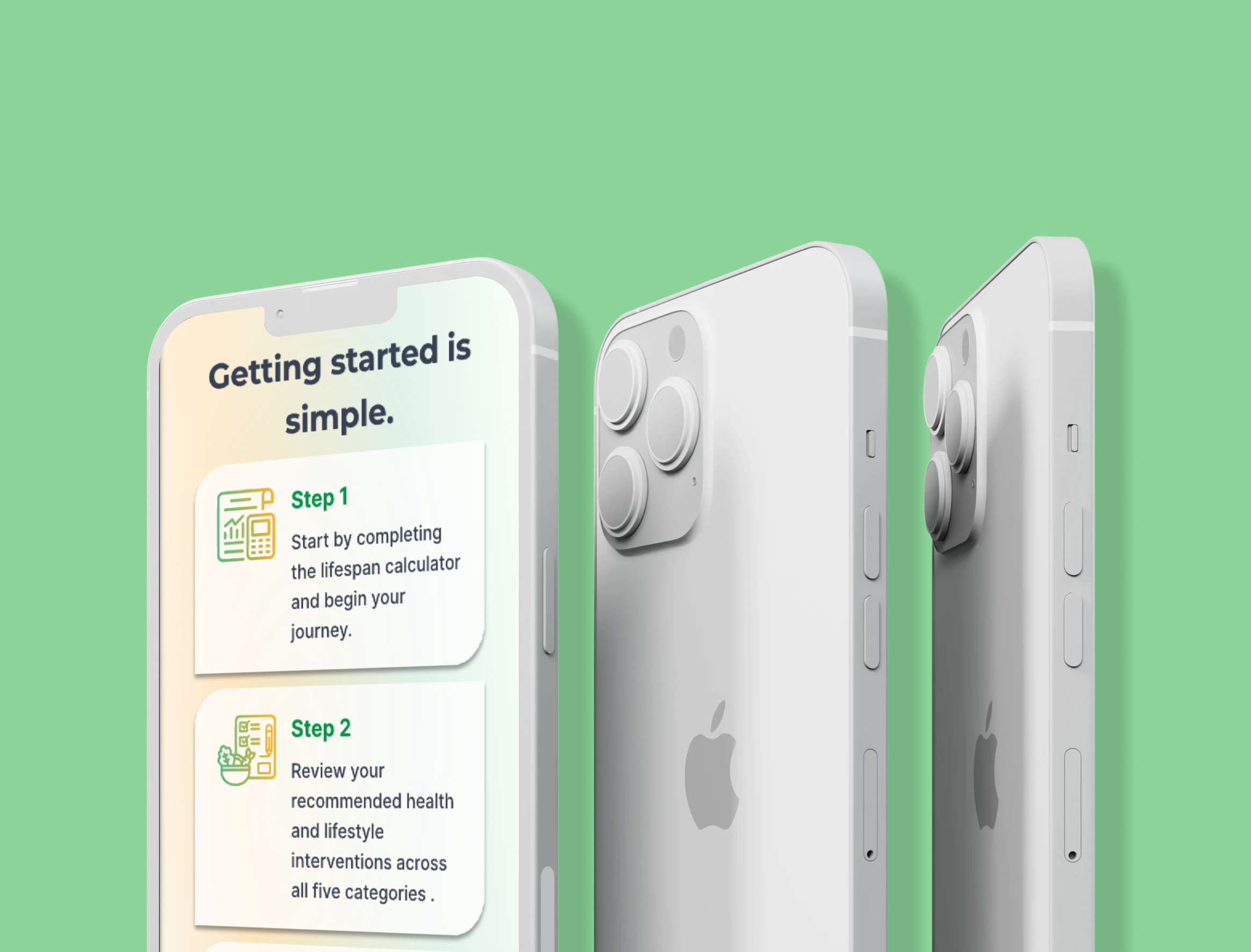My YouthspanProject
My Youthspan
My role
Product Designer & Researcher
Location & year
Remote, USA - 2025
MyYouthspan
AI-powered platform that predicts healthspan and guides users toward longer, healthier lives
About the project
MyYouthspan was created to meet the rising demand for accessible longevity solutions. Our team at Mety Technology designed a platform powered by an AI-driven Lifespan Calculator that helps users understand and improve their healthspan. We shipped a complete product ecosystem combining predictive insights, daily tracking, and personalized guidance.
My Crew: 2 designers, 1 PM, 2 frontend engineers, 2 backend engineers, 1 data scientist, 1 medical advisor
Brief
MyYouthspan is a longevity platform that helps people age smarter and live younger. At the core is an AI-powered Lifespan Calculator that predicts biological age and healthspan. The system analyzes lifestyle habits, biometrics, and lab results, then applies machine learning models to estimate life expectancy and future health risks. These predictions are integrated into a Daily Log and personalized plans that turn complex science into simple, motivating guidance and suggestions.
My Contribution
Conducted user interviews with 15 participants (mix of health enthusiasts and skeptics) to test interpretations of probabilistic outputs
Designed data → prediction flows mapping raw inputs (wearables, labs, survey data) to AI insights
Developed a design system with standards for representing probabilities, uncertainty ranges, and explainability elements
Built onboarding, calculator, dashboard, and daily log flows with progressive disclosure of detail, ensuring transparency without overwhelming users
Background & challenge
Research shows lifestyle factors like sleep, nutrition, and exercise can extend healthy years of life. Recent advances in machine learning now make it possible to forecast biological age and health span.
But this opportunity comes with hard problems:
Probabilistic outputs are often misinterpreted as guarantees
Black-box models reduce trust in algorithmic predictions
Health data is fragmented across wearables, apps, and labs
Our challenge: translate survival analysis outputs into a user experience that was scientifically rigorous, ethically transparent, and motivating without oversimplifying the complexity.
AI’s Role
The Lifespan Calculator was powered by:
Cox Proportional Hazards + Kaplan–Meier survival curves → predicting healthspan probabilities and identifying key lifestyle factors
Bayesian Updating → dynamically adjusting projections as new lab or lifestyle data was added
Feature weighting → identifying which habits (e.g., sleep regularity, BMI, cholesterol) most strongly shifted outcomes
Our design challenge was to present uncertainty, probabilities, and shifting forecasts in a way that felt empowering and trustworthy, rather than abstract or fatalistic.
User Interviews
We ran 15 interviews with a mix of participants:
Health enthusiasts already using wearables, fitness apps, and labs
Skeptics who were curious about longevity but distrusted black-box predictions
Interview Outcome
Users wanted clarity, consistency, and transparency. They valued seeing how their actions shaped results and trusted guidance backed by clear explanations.
Design Approach
Based on these insights, we defined four design challenges to guide early prototyping and testing:
Research & Findings
I conducted interviews with adults (ages 25–60), observed how they currently manage their health routines, and analyzed their use of wellness apps, wearables, and self-tracking tools. The research revealed fundamental gaps that limit long-term engagement with longevity practices.
People wanted one reliable prediction source instead of conflicting apps
They needed centralized views linking daily habits with long-term outcomes
They preferred automated tracking, since manual entry wasn’t sustainable
Technical Integration
We aligned design requirements with survival models like Cox proportional hazards and Gompertz functions. Personas reflected different attitudes toward data, from skeptics to optimizers. Journey maps revealed when predictions felt abstract or discouraging. Prototypes tested ways to visualize survival models as simple progress rings and dashboards. Usability testing refined how uncertainty was explained so it motivated action rather than confusion.
User Roles
This product is designed for two user groups: Health Seekers and Longevity Explorers:
Journey Mapping
To create a holistic solution, we mapped the current user journey from intention to action and layered pain points at each stage. We then overlaid design values onto the journey, allowing us to re-evaluate the concept and features as a whole. This ensured that users’ goals could be achieved, their frustrations relieved, and unnecessary complexity avoided.
Information Architecture
To align the structure with user needs and the technical realities of the AI model, we held several rounds of feedback with the product manager, engineers, and medical advisor. Each iteration refined how data, predictions, and insights connected, creating a clearer and more trustworthy experience.
Prototyping, Testing & Iteration
To align the structure with user needs and the technical realities of the AI model, we held several rounds of feedback with the product manager, engineers, and medical advisor. Each iteration refined how data, predictions, and insights connected, creating a clearer and more trustworthy experience.
First round of user testing and iteration
Problem
The original output from the AI model used a Kaplan Meier survival curve a statistically accurate but highly technical visualization. During testing, users described it as “intimidating,” “too scientific,” and “hard to connect to my daily actions.” The linear, probabilistic graph felt abstract and fixed, making users perceive lifespan as a static outcome rather than something they could influence.
Solution
We redesigned the visualization to make predictions feel understandable, dynamic, and empowering. The survival curve was replaced with a progress ring that displayed projected healthspan change and top influencing factors such as sleep, exercise, and stress. Confidence ranges were visualized subtly in the background, turning uncertainty into clarity.
The result transformed a complex statistical model into a human-centered feedback loop, helping users see how small actions could meaningfully extend their healthy years.
Problem
Landing Page — First Impression
Early usability testing revealed that the original landing page (left) felt heavy and marketing-focused. Users struggled to understand what MyYouthspan actually did beyond selling plans. The scientific foundation and simplicity of starting were buried under long scrolls and dense visuals.
Solution
The redesigned version (right) streamlined the structure around clarity and motivation. The hero section now communicates why MyYouthspan exists — “Live longer. Get healthier. Feel better — starting now.” Core benefits and steps to get started appear above the fold, reducing cognitive load.
Users reported stronger trust and comprehension in the first 10 seconds of viewing. Scroll depth increased by 42%, and 60% of users said the platform “felt more credible and science-based.”
Landing Page — A/B & Accessibility Testing
We conducted A/B testing on two landing page layouts to evaluate clarity, engagement, and perceived trust. The updated design performed significantly better, with users reporting that it felt more science-driven and easier to navigate.
In addition, accessibility testing with senior users helped refine font size, color contrast, and visual hierarchy, ensuring readability and ease of interaction across all age groups.
Outcome
The launch of MyYouthspan introduced one of the first consumer-facing experiences to translate AI-driven healthspan predictions into clear, actionable insights. Through iterative research and collaboration with data science and medical teams, we built a foundation for ethical, transparent, and motivating health AI design.
Improved user trust in probabilistic outputs through transparent explainability features
Established data-to-design standards now used across other Mety Technology wellness products
Created a shared design language for uncertainty, motivation, and health progress
What did users mention in the final user testing?
“It finally feels like an AI that explains itself, not just predicts.”
“This gives me control. It’s not guessing my future, it’s helping me shape it.”
MyYouthspan positioned Mety Technology as a credible player in longevity and health intelligence, bridging advanced predictive modelling with everyday decision-making for healthier living.

























